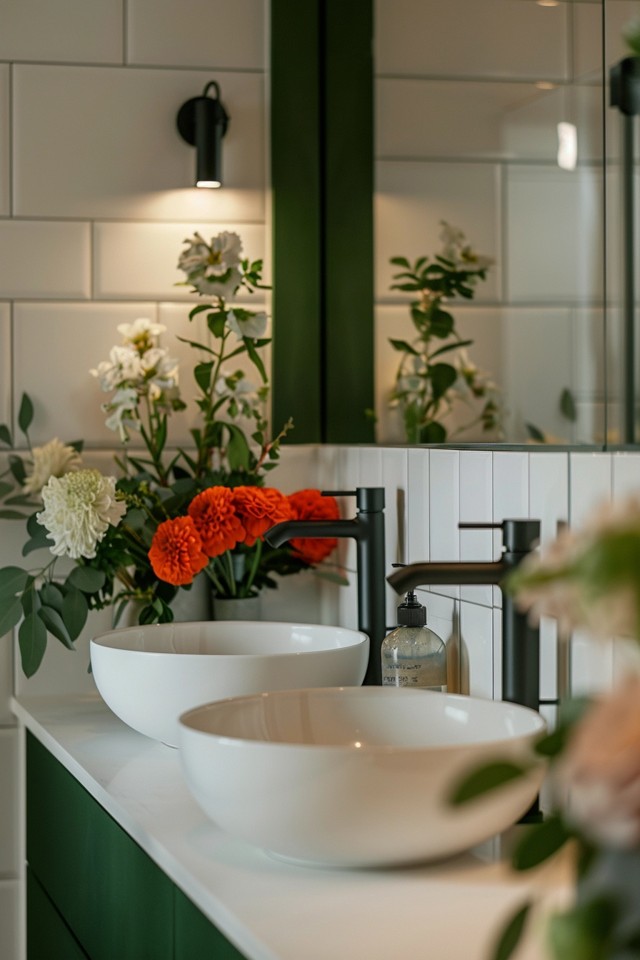Bathrooms are no longer just functional spaces; they have evolved into areas that reflect our values of inclusivity and diversity. The design of public restrooms has undergone significant changes to cater to the needs of all individuals, regardless of their gender identity. Creating gender-neutral or unisex bathrooms is a crucial step towards promoting a more inclusive society where everyone feels comfortable and respected.
When it comes to unisex bathroom ideas, there are numerous aspects to consider. From the layout and decor to the choice of accessories and colors, every element plays a role in creating an inviting and inclusive space. Here are some suggestions:
Key Takeaways:
- Unisex bathrooms are a way to provide inclusivity and safety for all individuals.
- Consider factors such as occupancy, safety, accessibility, space efficiency, waiting times, and cost when designing gender-neutral bathrooms.
- Incorporate multiple-user facilities with floor-to-ceiling doors and open handwashing areas for a more inclusive restroom design.
- Use signage and illustrations that promote inclusivity and accessibility.
- Provide sanitary product dispensers in all stalls to enhance the gender-inclusive nature of the space.
The Benefits and Challenges of Gender-Neutral Bathrooms
Gender-neutral or all-gender restrooms have gained significant attention in the design of public spaces. These facilities aim to create a more inclusive and safer environment, particularly for transgender individuals who may face harassment or discrimination in gender-segregated restrooms. By breaking away from traditional restroom design, gender-neutral bathrooms offer numerous benefits while also posing certain challenges.

- Safety: One of the primary advantages of gender-neutral restrooms is enhanced safety. By eliminating gender segregation, individuals are less likely to experience harassment or discomfort in these inclusive spaces.
- Equal Access: Gender-neutral bathrooms promote equality by providing access to all individuals, regardless of their gender identity. This ensures that everyone can use restroom facilities comfortably and without any hindrances or restrictions.
- Cost Efficiency: Designing gender-neutral restrooms can offer cost savings compared to creating separate male and female facilities. Consolidated spaces allow for better space utilization, potentially reducing construction, maintenance, and operating costs.
However, it’s important to address the challenges that arise with gender-neutral restroom design to ensure user comfort and safety.
- Privacy: Maintaining privacy is crucial in gender-inclusive spaces. Solutions may include fully-enclosed stalls with floor-to-ceiling doors or individual rooms equipped with locks to provide privacy and a sense of security.
- Proximity: Strategically placing amenities, such as sinks and hand dryers, can ensure convenience while maintaining a comfortable level of proximity for all users.
- Cleanliness: Proper ventilation and cleaning protocols must be implemented to address any concerns about odors or unsanitary conditions. Regular maintenance routines are essential for creating a clean and hygienic restroom environment.
- Cultural Considerations: Designing gender-inclusive spaces requires sensitivity to diverse cultural norms and sensitivities. Thoughtful language and signage play a crucial role in promoting inclusivity and understanding across different communities.
“Gender-neutral restrooms provide a safe and inclusive environment for all individuals, while also addressing concerns related to privacy, cleanliness, and cultural considerations.”
By approaching restroom design with a universal and inclusive mindset, architects and designers can create spaces that are welcoming and supportive for all individuals. The implementation of gender-neutral restrooms not only benefits the transgender community but also fosters a more inclusive society where everyone can feel comfortable and respected.
As we strive for greater inclusivity, it’s essential to recognize the advantages of gender-neutral restroom design while proactively addressing the associated challenges. By taking into account the needs and experiences of all individuals, restroom facilities can provide a more equitable and inclusive space for everyone.

The Future of Restroom Design and Gender Inclusivity
Restroom design is an evolving field, with an increasing focus on gender inclusivity and universal design principles. As society becomes more aware of the importance of creating inclusive spaces, efforts are being made to establish standardized layouts and rules for gender-neutral restrooms, ensuring consistency and accessibility for all individuals.
International building and plumbing codes have been updated to include gender-neutral restroom requirements, reflecting a larger shift towards inclusivity in the design industry. In addition to regulatory standards, many jurisdictions have taken additional steps to promote inclusiveness, encouraging architects and designers to explore innovative solutions.
However, the concept of gender-neutral design extends beyond restrooms. It encompasses various aspects of our built environment, including public facilities and corporate spaces. By considering the diverse needs and perspectives of users, architects and designers can create environments that are welcoming and accommodating for everyone.
Embracing the principles of universal design is essential in achieving this goal. Equitable use, flexibility, and simple intuitive use are the cornerstones of universal design, allowing spaces to be accessible and functional for people of all abilities and identities.
The future of restroom design envisions a rise in gender-neutral spaces, not only in public facilities but also in corporate environments. Many organizations have recognized the importance of creating gender-inclusive spaces for their employees and visitors, reflecting a broader commitment to diversity and equality.


